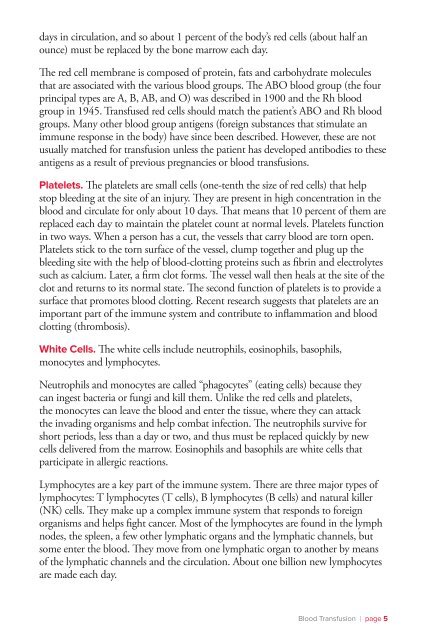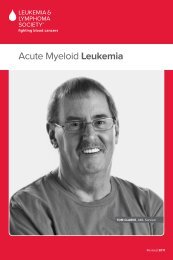Blood Transfusion (PDF) - The Leukemia & Lymphoma Society
Blood Transfusion (PDF) - The Leukemia & Lymphoma Society
Blood Transfusion (PDF) - The Leukemia & Lymphoma Society
Create successful ePaper yourself
Turn your PDF publications into a flip-book with our unique Google optimized e-Paper software.
days in circulation, and so about 1 percent of the body’s red cells (about half an<br />
ounce) must be replaced by the bone marrow each day.<br />
<strong>The</strong> red cell membrane is composed of protein, fats and carbohydrate molecules<br />
that are associated with the various blood groups. <strong>The</strong> ABO blood group (the four<br />
principal types are A, B, AB, and O) was described in 1900 and the Rh blood<br />
group in 1945. Transfused red cells should match the patient’s ABO and Rh blood<br />
groups. Many other blood group antigens (foreign substances that stimulate an<br />
immune response in the body) have since been described. However, these are not<br />
usually matched for transfusion unless the patient has developed antibodies to these<br />
antigens as a result of previous pregnancies or blood transfusions.<br />
Platelets. <strong>The</strong> platelets are small cells (one-tenth the size of red cells) that help<br />
stop bleeding at the site of an injury. <strong>The</strong>y are present in high concentration in the<br />
blood and circulate for only about 10 days. That means that 10 percent of them are<br />
replaced each day to maintain the platelet count at normal levels. Platelets function<br />
in two ways. When a person has a cut, the vessels that carry blood are torn open.<br />
Platelets stick to the torn surface of the vessel, clump together and plug up the<br />
bleeding site with the help of blood-clotting proteins such as fibrin and electrolytes<br />
such as calcium. Later, a firm clot forms. <strong>The</strong> vessel wall then heals at the site of the<br />
clot and returns to its normal state. <strong>The</strong> second function of platelets is to provide a<br />
surface that promotes blood clotting. Recent research suggests that platelets are an<br />
important part of the immune system and contribute to inflammation and blood<br />
clotting (thrombosis).<br />
White Cells. <strong>The</strong> white cells include neutrophils, eosinophils, basophils,<br />
monocytes and lymphocytes.<br />
Neutrophils and monocytes are called “phagocytes” (eating cells) because they<br />
can ingest bacteria or fungi and kill them. Unlike the red cells and platelets,<br />
the monocytes can leave the blood and enter the tissue, where they can attack<br />
the invading organisms and help combat infection. <strong>The</strong> neutrophils survive for<br />
short periods, less than a day or two, and thus must be replaced quickly by new<br />
cells delivered from the marrow. Eosinophils and basophils are white cells that<br />
participate in allergic reactions.<br />
Lymphocytes are a key part of the immune system. <strong>The</strong>re are three major types of<br />
lymphocytes: T lymphocytes (T cells), B lymphocytes (B cells) and natural killer<br />
(NK) cells. <strong>The</strong>y make up a complex immune system that responds to foreign<br />
organisms and helps fight cancer. Most of the lymphocytes are found in the lymph<br />
nodes, the spleen, a few other lymphatic organs and the lymphatic channels, but<br />
some enter the blood. <strong>The</strong>y move from one lymphatic organ to another by means<br />
of the lymphatic channels and the circulation. About one billion new lymphocytes<br />
are made each day.<br />
<strong>Blood</strong> <strong>Transfusion</strong> I page 5

















